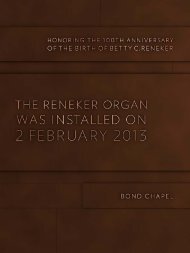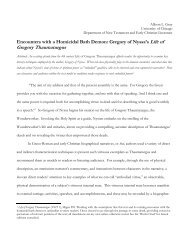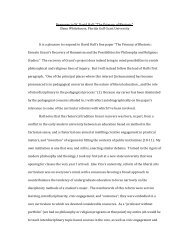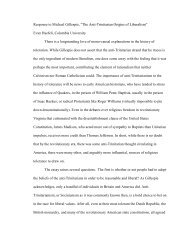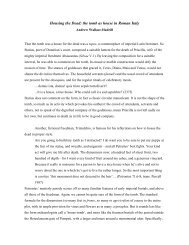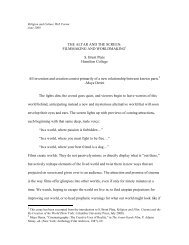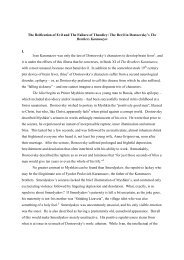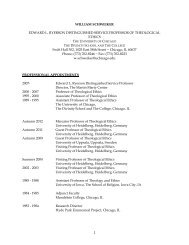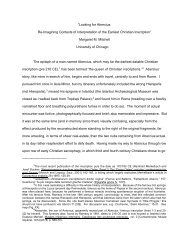*Criterion Winter 02-4.16 - Divinity School - University of Chicago
*Criterion Winter 02-4.16 - Divinity School - University of Chicago
*Criterion Winter 02-4.16 - Divinity School - University of Chicago
You also want an ePaper? Increase the reach of your titles
YUMPU automatically turns print PDFs into web optimized ePapers that Google loves.
2 W INTER 20<strong>02</strong><br />
RELIGION AND SCIENCE,<br />
FAITH AND REASON<br />
There seem to be two main approaches in the literature. The<br />
bad, old approach is exemplified by two books from the nineteenth<br />
century: John William Draper’s History <strong>of</strong> the Conflict<br />
between Religion and Science (New York, 1874, with a twentyfirst<br />
edition in 1890), and Andrew Dickson White’s A History<br />
<strong>of</strong> the Warfare <strong>of</strong> Science with Theology in Christendom (New<br />
York, 1896). Both are classics in the literature: the first written<br />
by a scientist in the defense <strong>of</strong> free inquiry, and the second by<br />
a historian, the first president <strong>of</strong> Cornell <strong>University</strong>, as part <strong>of</strong><br />
his brief for a secular university grounded in the sciences.<br />
There are some subtle differences in their approaches to the<br />
subject. Draper is concerned with religion in general, while<br />
White is concerned with theology. Draper’s criticisms are<br />
directed against religion as such, while White is more focused<br />
against the Roman Catholic Church. But both are united in<br />
seeing the two institutions <strong>of</strong> science and religion as, in some<br />
sense, being fundamentally opposed to one another. Their stories<br />
derive from one particular strand <strong>of</strong> the eighteenth-century<br />
Enlightenment, which sees evil, dogmatic, and antirational<br />
religion standing against progress, as represented by the new<br />
scientific worldview. The key examples <strong>of</strong> this view might be the<br />
condemnation <strong>of</strong> Galileo in early seventeenth-century Rome<br />
and the battle over evolutionism and creationism that started<br />
with Darwin and his opponents and continues to this day.<br />
SOME PASCALIAN REFLECTIONS<br />
Daniel Garber<br />
n this lecture I would like to discuss the relation between religion and science—more broadly, the<br />
relation between religion and reason. The topic is hardly new. Important discussions that explicitly<br />
focus on this question can be found in the writings <strong>of</strong> all <strong>of</strong> the Abrahamic monotheistic religions—<br />
Judaism, Christianity, and Islam. But, in recent years, the discussions have become particularly intense.<br />
Perhaps it is the result <strong>of</strong> recent advances in science, or <strong>of</strong> a large cash prize <strong>of</strong>fered by the Templeton<br />
Foundation for work in the area, I don’t know. But the literature has been expanding at a rapid rate.<br />
The more recent literature, by contrast, has a markedly<br />
different tone in which there is no real contradiction between<br />
science and religion. This view is nicely exemplified in the<br />
work <strong>of</strong> Ian Barbour and his followers (whom one might<br />
call the Barbourians). Barbour’s thought about religion<br />
and science is centered around a four-fold schema that is<br />
supposed to encompass all the views that have been taken<br />
on the subject. The four categories are conflict, independence,<br />
dialogue, and integration. The views <strong>of</strong> Draper and White,<br />
that religion and science are inherently conflictual, obviously<br />
fit into Barbour’s first category. The view that science and<br />
religion have their separate and equal domains, and that<br />
they coexist by not interacting with one another, is what<br />
Barbour means by independence. Dialogue is the category<br />
into which Barbour puts views that stress the similarities<br />
between science and religion, while maintaining that they<br />
are distinct enterprises: “Dialogue emphasizes similarities<br />
in presuppositions, methods, and concepts, whereas Independence<br />
emphasizes differences.” 1 Finally, integrationists<br />
attempt to merge science and theology into a single picture,<br />
a natural theology or a theology <strong>of</strong> nature, or a genuine<br />
This essay is based on the 2001 John Nuveen Lecture Mr.<br />
Garber delivered on October 18, 2001, in Swift Lecture Hall.



